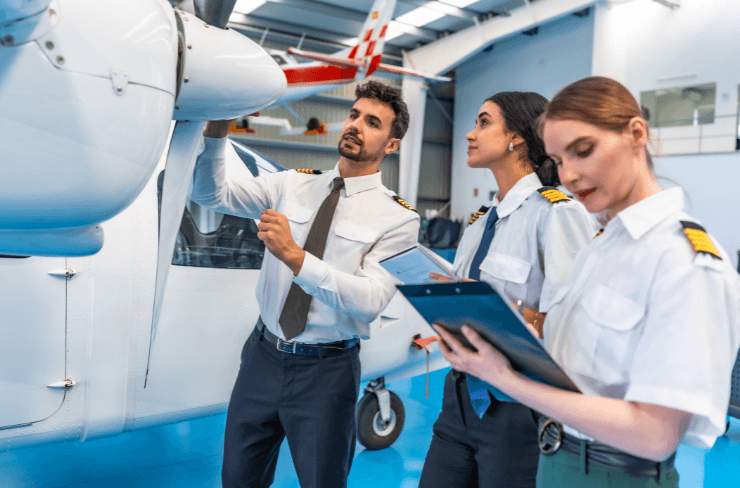How to Overcome Common Challenges in Aviation Maintenance

Aviation maintenance is a cornerstone of the aerospace industry, ensuring safety, efficiency, and reliability. However, as the complexity of operations grows, so do the challenges faced by professionals in the field. From minimising downtime to maintaining regulatory compliance, these hurdles can have significant operational and financial impacts.
Key Challenges in Aviation Maintenance
Downtime Costs
Grounded aircraft are a major contributor to financial losses in the aviation industry. Every hour of downtime can cost airlines thousands of dollars, with industry-wide losses exceeding $150 billion annually. Unscheduled maintenance is one of the leading causes of delays, highlighting the urgent need for predictive tools that minimise downtime.
Complex Compliance Requirements
The aviation sector is heavily regulated, requiring excellent record-keeping and adherence to strict standards. Compliance is not optional - violations can result in hefty fines, reputational damage, or even safety risks. Many organisations struggle to maintain accurate documentation, especially when relying on manual processes or siloed systems.
Data Management and Integration
Legacy systems often lead to fragmented data storage, making it difficult for teams to share, analyse, or retrieve critical information. Without an integrated platform, inefficiencies and errors creep into workflows, complicating maintenance tasks and impacting decision-making.
Manual Processes
Even with technological advancements, manual processes like data entry and spreadsheets are still prevalent in aviation maintenance. While these methods may seem simple, they are prone to human error, time-consuming, and unsuitable for managing modern fleets.
High Costs of Upgrading Systems
The perceived cost of adopting modern tools can deter organisations from upgrading. Long implementation times, hidden fees, and a lack of clarity around pricing add to the hesitancy. However, these outdated systems often cost more in the long term due to inefficiencies and downtime.
Solutions to Improve Maintenance Operations
Addressing these challenges requires a combination of modern tools, strategic planning, and forward-thinking approaches. Here are some proven solutions:
- Adopt Predictive Maintenance: Predictive maintenance leverages advanced analytics to anticipate issues before they arise. By monitoring the condition of key components like engines and avionics, organisations can significantly reduce downtime while extending the lifespan of their assets.
- Embrace Real-Time Data Access: Implementing tools that provide real-time insights into fleet performance, compliance, and inventory allows teams to make informed decisions quickly. For example, digital dashboards can offer a clear overview of KPIs, ensuring nothing falls through the cracks.
Integrate Systems for Efficiency
Modern aviation maintenance tools offer seamless data integration, centralising maintenance records, compliance reports, and inventory details in one platform. This eliminates the inefficiencies of siloed systems and fosters collaboration across teams.
- Invest in Training and User-Friendly Tools: Even the most advanced tools require a knowledgeable team to operate them. While intuitive platforms with simple interfaces can reduce training time, providing proper onboarding for staff ensures a smooth transition and maximised efficiency.
- Implement Transparent, Cost-Effective Solutions: Next-gen MRO software often comes with transparent pricing and scalable features, reducing the financial burden of adoption. Organisations can focus on operational improvements without worrying about hidden costs or extended deployment times.
Best Practices for Staying Ahead
Adopting the right strategies is just as important as using the right tools to remain competitive in today's rapidly evolving aviation industry.
- Conduct Regular Audits: Evaluate your maintenance workflows frequently to identify inefficiencies and bottlenecks. Streamlining these processes ensures your organisation stays on top of evolving demands.
- Digitalise Maintenance Records: Shift from paper-based logs to electronic records like aircraft techlogs. Digital logbooks not only simplify compliance but also reduce the risk of errors while improving accessibility.
- Stay Informed About Emerging Technologies: The aviation industry is rapidly advancing with innovations such as AI, IoT, and automation. Staying updated on these trends ensures your organisation can leverage the best tools for long-term success.
The Path Forward: Embracing Modern Maintenance Solutions
Overcoming challenges in aviation maintenance requires a blend of modern strategies and innovative tools. AirNxt, a next-gen MRO software, is designed to address these pain points with features like predictive maintenance, seamless data integration, and real-time analytics. By adopting solutions like AirNxt, aviation professionals can optimise operations, reduce downtime, and stay ahead in a rapidly evolving industry.



